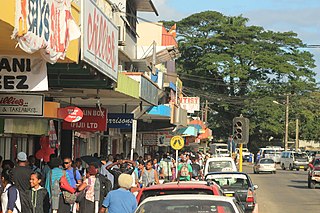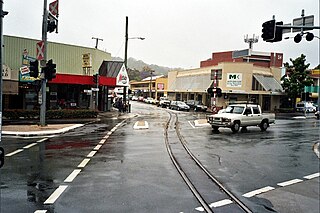Related Research Articles
CSR Limited is a major Australian industrial company, producing building products and having a 25% share in the Tomago aluminium smelter located near Newcastle, New South Wales. It is publicly traded on the Australian Securities Exchange. In 2021, it had over 3,000 employees and reported an after-tax profit of $146 million. The company has a diversified shareholding with predominantly Australian fund managers and retail owners. The group's corporate headquarters is in North Ryde, Sydney.

Pudding Mill Lane is a Docklands Light Railway (DLR) station in Stratford in London, England. It opened in 1996 on the road of the same name, once a light industrial area in Stratford, now being redeveloped into housing development called Pudding Mill Lane. It is next to the Olympic Park; however, it was closed for the duration of the 2012 Olympic Games and reopened on 12 September 2012. The original island platform station was permanently closed on 18 April 2014 in order to allow for the construction of a ramp from the new Crossrail portal nearby. A new, larger station built a short distance to the south opened on 28 April 2014.

The Calder Valley line is a railway route in Northern England between the cities of Leeds and Manchester as well as the seaside resort of Blackpool. It is the slower of the two main rail routes between Leeds and Manchester, and the northernmost of the three main trans-Pennine routes.

The South Coast Railway is a commuter and goods railway line from Sydney to Wollongong and Bomaderry in New South Wales, Australia. Beginning at the Illawarra Junction, the line services the Illawarra and South Coast regions of New South Wales.

Nausori is a town in Fiji. It had a population of 57,866 at the 2017 census. This makes it the fourth most populous municipality in the country. Situated 19 kilometers outside of Suva, it forms one pole of the burgeoning Suva-Nausori corridor. Nausori is home to three provinces Rewa, Tailevu and Naitasiri.
Naitasiri is one of the 14 provinces of Fiji and one of eight located on Viti Levu, Fiji's largest island.

The North Coast railway line is a 1,681-kilometre (1,045 mi) 1067 mm gauge railway line in Queensland, Australia. It commences at Roma Street station, Brisbane, and largely parallels the Queensland coast to Cairns in Far North Queensland. The line is electrified between Brisbane and Rockhampton. Along the way, the 1680 km railway passes through the numerous towns and cities of eastern Queensland including Nambour, Bundaberg, Gladstone, Rockhampton, Mackay and Townsville. The line though the centre of Rockhampton runs down the middle of Denison Street.

The North Coast Line is the primary rail route in the Mid North Coast and Northern Rivers regions of New South Wales, Australia, and forms a major part of the Sydney–Brisbane rail corridor.
The Colonial Sugar Refining Company (CSR) began operations in Fiji in 1880 and until it ceased operations in 1973, had a considerable influence on the political and economic life of Fiji. Prior to its expansion to Fiji, the CSR was operating Sugar Refineries in Melbourne and Auckland. The decision to enter into the production of raw sugar and sugar cane plantation was due to the Company's desire to shield itself from fluctuations in the price of raw sugar needed to run its refining operations. In May 1880 Fiji's Colonial Secretary John Bates Thurston persuaded the Colonial Sugar Refining Company to extend their operations into Fiji by making available 2,000 acres (8 km²) of land to establish plantations.
Rail transport in Fiji moves cut sugar cane to crushing mills. Also, there used to be two horse-drawn street tramway systems, some other passenger systems, an underground mine system, and some tramways on construction projects. There are multiple other modes of transport in Fiji.
Sugar cane grew wild in Fiji and was used as thatch by the Fijians for their houses (bures). The first attempt to make sugar in Fiji was on Wakaya Island in 1862 but this was a financial failure. With the cotton boom of the 1860s there was little incentive to plant a crop that required high capital outlay but after a slump in cotton prices in 1870, the planters turned to sugar. In an effort to promote the production of sugar in Fiji, the Cakobau Government, in December 1871, offered a 500-pound reward for the first and best crop of twenty of sugar from canes planted before January 1873.
The Penang Sugar Mill in Rakiraki, Fiji was one of the four sugar mills operated by the Fiji Sugar Corporation. The FSC is the sole producer of raw sugar in Fiji.

The Bristol and South Wales Union Railway was built to connect Bristol, England, with south Wales. The route involved a ferry crossing of the River Severn but was considerably shorter than the alternative route through Gloucester. The ferry was replaced by the Severn Tunnel in 1886 but part of the route continues to be used, forming parts of the Cross-Country Route and the South Wales Main Line.

The Main Line is a railway line in South East Queensland, Australia. It was opened in a series of sections between 1865 and 1867. It commences at Roma St Station in Brisbane and extends west 161 km to Toowoomba. It is the first narrow gauge main line constructed in the world. The section of the line from the end of Murphys Creek railway station to the Ruthven Street overbridge, Harlaxton is listed on the Queensland Heritage Register. The Murphys Creek Railway Complex, the Lockyer Creek Railway Bridge (Lockyer), the Lockyer Creek Railway Bridge and Swansons Rail Bridge are also heritage listed.

Moreton Central Sugar Mill Cane Tramway is a heritage-listed tramway at Mill Street, Currie Street, and Howard Street, in Nambour, Sunshine Coast Region, Queensland, Australia. It was built c. 1897. It was added to the Queensland Heritage Register on 7 February 2005.

Central Sugar Mill Ruins is a heritage-listed former sugar cane mill at Old Mill Road, Yengarie, Fraser Coast Region, Queensland, Australia. It was built from 1866 to 1890s. It was added to the Queensland Heritage Register on 5 December 2005.

Finch Hatton railway station is a heritage-listed former railway station at Mackay-Eungella Road, Finch Hatton, Mackay Region, Queensland, Australia. It was built in 1904. It is also known as Hatton railway station and Pelion railway station. It was added to the Queensland Heritage Register on 6 December 2004.

Mirani railway station is a heritage-listed former railway station on the former Pioneer Valley railway line at Victoria Street, Mirani, Mackay Region, Queensland, Australia. It was built from 1885 to 1913. It is also known as Hamilton railway station. It was added to the Queensland Heritage Register on 7 July 2005.

Habana Tramline Causeway and Wharf Site is a heritage-listed causeway between Habana Wharf Road and Constant Creek, Habana, Mackay Region, Queensland, Australia. It is also known as Habana Wharf Road. It was added to the Queensland Heritage Register on 14 May 2010.
Moreton Central Sugar Mill was a sugar milling facility in Nambour, Queensland, Australia owned by Bundaberg Sugar Ltd.
References
- ↑ Moynagh, Michael (1981). Brown or white? a history of the Fiji sugar industry, 1873-1973 (PDF). Canberra. p. 32. ISBN 0-908160-87-9.
CSR built five mills in Fiji between 1880 and 1903. One, at Viria on the upper Rewa, crushed for only ten years from 1886 to 1895 when, apparently too small to be viable, it was closed.
- ↑ Thiele, H. H. (August 1891). "Rewa River, Fiji". Scottish Geographical Magazine. 7 (8): 440. doi:10.1080/00369229108732472. ISSN 0036-9225.
Even the hills have not been spared, and a tunnel through a range at Viria allows sugar-cane grown along the Wai-Dina to be transported by rail to the Viria Mill.